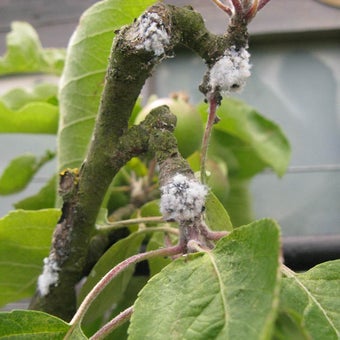
Quick facts
Common name - Apple canker
Scientific name - Neonectria ditissima (syn. Neonectriagalligena,Nectria galligena)
Plants affected - Mainly apples
Main symptoms - Round or oval areas of dead, sunken bark
Caused by - Fungus
Timing - New cankers form from mid-spring
What is apple canker?
is a disease caused by a fungus, Neonectria ditissima, which attacks the of apples and some other trees, causing a sunken area of dead bark and, eventually, death of the branch. New cankers form from mid-spring, and once formed are present all year. Cankers can also develop on the trunk.
Apples are the most important hosts, although pears and Sorbus species are also attacked and, less frequently, ash, beech and some other trees.
Symptoms
Cankers are round or oval areas of dead, sunken , often starting at a wound or a .
You may see the following symptoms:
- On small branches and fruiting spurs: The infection may girdle the stem and kill it in a single season. The bark often flakes off infected smaller twigs
- On larger branches and/or the trunk: Cankers are , with the affected area covered with dead bark that sometimes shows concentric rings indicating periods of active spread. Older cankers lose the bark, exposing dead wood in the centre. Perennial cankers develop raised edges as the tree’s bark attempts to grow back over the exposed area. Eventually the branch will die above the canker, being progressively weakened as the bark is killed
- On fruit: Developing fruits are sometimes attacked, and will rot and fall

Control
Non chemical control
Canker is said to be more serious on wet, heavy and/or acid soils, so pay attention to drainage and raise the soil pH by liming if needed.
Completely cut out all affected smaller branches and spurs. With the larger branches, try to cut out all infected material. All such pruning should remove all brown, infected and wood, cutting back to fresh green tissues. Paint immediately with a protective wound paint such as Medo, Growing Success Prune & Seal or Provanto Arbrex Seal and Heal, to prevent the wounds becoming reinfected.
Inclusion of a product does not indicate a recommendation or endorsement by the RHS. It is a list of products currently available to the home gardener.
No variety is completely resistant under all conditions, but the following all show some resistance: ‘Alfriston’, ‘Annie Elizabeth’, ‘Brownlees Russet’, ‘Cockle Pippin’, ‘Crawley Beauty’, ‘D’Arcy Spice’, ‘Emneth Early’, ‘Grenadier’, ‘John Standish’, ‘Katy’ (‘Katya’), ‘Lane’s Prince Albert’, ‘Lord Derby’, ‘Merton Russet’, ‘Newton Wonder’, ‘Orleans Reinette’, ‘Reverend W. Wilkes’, ‘Rosemary Russet’, ‘Winston’.
Some varieties are particularly susceptible to canker and these include ‘Cox’s Orange Pippin’, ‘Lord Suffield’, ‘James Grieve’, ‘Ribston Pippin’, ‘Worcester Pearmain’, ‘Ellison’s Orange’ and ‘Spartan’.
Chemical control
Apart from the wound paints described above, no products are available to gardeners for the control of .
Download
Fungicides for gardeners (Adobe Acrobat pdf document giving further details of wound paints available to gardeners)
Link
Biology
The fungus produces white pustules of water-dispersed spores from the edges of the lesions in summer, and airborne spores from small red structures in the winter and spring. Both can initiate infections, usually through wounds including pruning cuts. Damage left by falling leaves (leaf scars), frost, scab disease, and woolly aphid are also routes for infection.
In cankers there is an interaction between fungus and tree. At some periods the canker spreads whilst at others the grows back over infected tissues. Sometimes the canker stabilises or heals but, more usually, it spreads gradually until the branch is girdled, or so weakened that it breaks.









